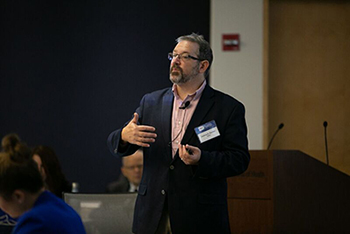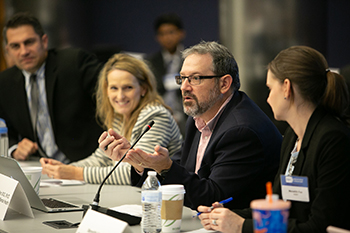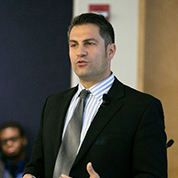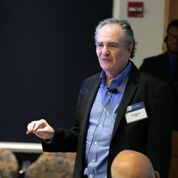Archived Content
The National Institute of Mental Health archives materials that are over 4 years old and no longer being updated. The content on this page is provided for historical reference purposes only and may not reflect current knowledge or information.
NIMH Alliance for Research Progress Meeting
Date
Location
Welcome and Introductions
Joshua Gordon, M.D., Ph.D., Director, NIMH

The National Institutes of Mental Health (NIMH) convened its 25th annual meeting of the Alliance for Research Progress (Alliance or Alliance members) at the National Institutes of Health Campus in Bethesda, MD, with NIMH Director, Dr. Joshua Gordon, presiding. Dr. Gordon welcomed participants, noting that the annual gathering provides an important opportunity to hear from the advocacy community, as well as share and solicit feedback and questions on recent NIMH activity. The Alliance includes individuals representing key national organizations devoted to mental health issues, and patient and family/caregiver advocacy. The highlights of the meeting are summarized below. The meeting agenda and participant list are also available for reference.
Director's Update

Dr. Gordon stated that NIMH and the Alliance share common missions; that is, to transform understanding and treatment of mental illnesses, emphasizing the importance of ‘transform’ to mutual goals and outcomes. He shared that while the opioid epidemic and suicide rates have dominated media headlines, Congressional members remain interested and engaged in neuroscience and broader mental health issues with which NIMH is deeply engaged; this has been exemplified by NIMH participation in/presence at numerous briefings, roundtable discussions, and summits on topics ranging from the Brain Research through Advancing Innovative Neurotechnologies® (BRAIN) Initiative and suicide prevention, to autism and Research Domain Criteria (RDoC). Moving on to Institutional updates, Dr. Gordon said that consistent increases in the NIMH budget have allowed for the awarding of ~600 research grants, and that with Congressional minibus funding, an additional $2B more than FY2018 (total = $39.1B), and $98M over FY2018 (total=$1.8M) has been awarded to NIH and NIMH, respectively. NIMH has also expanded public resource offerings to include a user experience-based home website page, customization-friendly statistical graphs, and new publications. Additionally, NIMH has undergone departmental changes that will facilitate a collaborative approach to Institute-wide priorities. These include aligning the genomics and global mental health research division portfolios to allow prioritization of mental health disparities research, and enhancing intra- and extramural interactions. Dr. Gordon noted that the Institute is currently accepting applications for a new director to lead the Office of Disparities Research Workforce Diversity. In Workgroup news, the Genomics Workgroup has made significant progress in understanding the underpinnings of mental disorders through its work on the genome, and the RDoC changes to the Matrix Workgroup is working on a reorganization of its Positive Valence Domain, also adding a new Sensorimotor Domain. Dr. Gordon then proceeded to share information on several NIH-wide initiatives, including: 1) the All of Us Research Program which aims to assess one million participants to inform precision medicine (Dr Gordon encouraged Alliance members to continue to spread the word to promote participation); 2) Helping to End Addiction Long-termSM (HEAL) Initiative, a trans-agency effort to stem the opioid crisis; 3) the Adolescent Brain Cognitive Development (ABCD) study which enrolled more than 7,500 participants ages 9-10 years, and 4) the BRAIN Initiative Advisory Working Group 2.0, and BRAIN Initiative Cell Census Network. In addition, Dr. Gordon highlighted studies on ketamine and suicidal ideation/depression, neurobiological and polygenic risk factors for schizophrenia, and early life/prenatal exposures and autism spectrum disorder (ASD) risk. Dr. Gordon concluded by reinforcing the Institute’s future goals, which include prioritization of excellent science and diversity, and the desire to work with the Alliance to help to continue to inform both research and related momentum toward treatments.
Discussion
The discussion first focused on the appropriateness of buprenorphine for mental health disorders, which Dr. Gordon noted, lacked compelling data. Likewise, when asked about ketamine for children with depression, Dr. Gordon said given current usage in children, that it might be viable, but that data is lacking. Ms. Rutherford inquired if NIMH was pursuing any longitudinal studies examining sensory sensitivity and borderline personality in children, to which Dr. Gordon replied that this was also an issue in ASD, but that he was uncertain if it was being specifically studied. Mr. Counts inquired if NIMH was exploring the changing epidemiology of childhood, and its ramifications for clinical interventions; Dr. Gordon noted that ABCD may be able to detect certain phenomenology. Ms. Lyster-Mensh expressed that terminology matters, asking Dr. Gordon if he had a position on ‘mental’ vs. ‘brain’ disorders. Dr. Gordon was quick to note that everything studied, every action taken, every initiative has one focus: diseases of the brain. Ms. Webster wondered if the Institute was planning to collect data around increased cannabis accessibility, and related psychosis risks among children and teens? Discussion ensued around the ABCD inclusion of this topic, and Dr. Gordon also emphasized that risk focused more broadly on “all-comers” schizophrenia, beyond early onset psychosis. Additional discussion centered on NIMH-specific initiatives toward educating primary care and pediatric physicians, childhood mental health risks and interventions (Dr. Heinssen weighed in national collaborative care clinics implementation), and how NIMH determines budget/research allocation on focus.
Prediction and Prevention of Psychosis in At Risk Youth
Tyrone D. Cannon, Ph.D., Clark L. Hull Professor of Psychology and Psychiatry, Yale University

Dr. Cannon explained that the onset of psychosis is often preceded by a decline in functioning, and the appearance of unusual thoughts and perceptions. He added that large samples of clinical high-risk (CHR) individuals have been studied, with data showing that CHR individuals are highly distressed, and display positive symptoms at sub-psychotic intensity and impaired global functioning. This ‘prodromal’ phase is manifested by perplexity and confusion with regard to what is real vs imaginary, that which is familiar begins to feel strange, confusing or ominous, and that the reality basis of these experiences is unclear to the individual experiencing them. While 15% and 25% of these people will convert to full blown psychosis within 1 and 2 years, respectively (with more elaborate symptoms and loss of insight), those who don’t convert are likely to continue to manifest symptoms/impairment throughout their lifetime. Dr. Cannon’s group at Yale conducted the North American Longitudinal Study (NAPLS2) that aimed to determine whether hormonal, electrophysiological, and anatomical abnormalities mark the processes underlying the progression to full psychosis. Using an 8-variable, individualized, literature-based risk calculator, the team studied 556 help-seeking CHR persons, including 84 who converted to full-blown psychosis during 2-year follow up. Like other risk calculators (including cardiovascular disease), the calculator had a 71% predictability over 2 years (which allows for treatment planning, exposure susceptibility, etc.). The calculator is available to researchers and clinicians at https://riskcalc.org/napls/ . Dr. Cannon then cited data demonstrating its applicability and replicability in slightly younger CHR patients, adding that the calculator is most likely to be valuable for clinical trials design, especially in terms of mitigating exposure of false-positives to potential adverse events. Researchers have also explored if any magnetic resonance imaging (MRI)-based classification system examining multiple blood analytes could be used to predict psychosis conversions, with findings demonstrating increased signaling and connectivity within a cerebellar-thalamus-cortical network that could predict psychosis and time to conversion. With regard to treatment, Dr. Cannon explained that antipsychotic agents are limited in their ability to affect cognitive dysfunction and overall functioning, are not able to prevent conversion, are poorly tolerated, and must be maintained chronically. Therefore, research is focusing on discovering the mechanisms of onset, which appears to include a prefrontal thinning of the cortex, possibly driven by pro-inflammatory triggers. Noting that media attention to the complement component 4 (C4) gene was misleading, he said that not only is C4 only one of dozens of polymorphisms, but that it is important to consider plasticity-related targets. Consequently, ongoing work is looking at evidence for changes in inflammatory or N'-nitrosodimethylamine (NDMA)-dependent markers that precede/predict psychosis-relevant brain connectivity, and if biomarkers can be used to improve prediction for conversion, and guide selection of targeted interventions.
Discussion
Dr. Cannon explained that the risk calculator was placed behind a firewall with limited accessibility to protect against misuse or data misinterpretation, and that it was conceived to facilitate intervention-based research. Ms. Rutherford asked about the availability of information on the relationship between immune disorders or deficits in schizophrenia. Dr. Cannon noted that the immune system is actually ubiquitous and that its role in regulating homeostasis, including cortical connections, has been underappreciated. While microglia modulating activity contributes to psychosis onset, it’s still not clear in schizophrenia if specific mechanisms (e.g., progressive thinning of the cortex) are driven by immune system overactivity, or attenuated resistance driven by lower activity at synapses. He said the question could also be applied more broadly to mental disorders in general. Ms. Webster asked if one could use the connectivity studies to speculate on synaptic plasticity and pruning, to which Dr. Cannon replied that hyper-, not hypo-, connectivity might play a more active role in the emergence, and first years of psychosis, which he also noted was similar to what is observed in individuals during early at-risk stages for Alzheimer’s, or who are ApoE4 carriers. He added that this might be a compensatory or adaptive mechanism that eventually progresses to deficits. Finally, Mr. Counts inquired if the risk calculator will eventually be converted into a risk reduction model. Dr. Cannon explained that the opportunity might lie in engagement, and its effect on plasticity, that is, using the calculator as a motivator to prevent certain exposures (e.g., cannabis, street drugs) and promote others (social engagement).
Refinement and Testing of Interventions to Sustain ADHD Treatment Effects Across Settings and Developmental Transitions
Mary Rooney, Ph.D., Chief, Child and Adolescent Treatment Intervention Research Program, Division of Services and Intervention Research, NIMH

As an introduction, Dr. Gordon explained that concept clearances are used for initiatives needed to address certain research gaps; these are commonly presented publicly to ensure that all investigators learn about them at the same time. Once cleared, these concepts are posted on the NIMH website, and are available for further comment prior to proceeding. Notably, publication/timing of resultant funding opportunity announcements depends on sufficient funding. He said that while concept clearances are not typically presented to Alliance members, that this particular initiative was especially relevant. At the podium, Dr. Rooney continued, stating that the concept goal was to support research evaluating the preliminary effectiveness of augmented or modified interventions geared toward enhanced and sustained improvement in attention-deficit/hyperactivity disorder (ADHD) symptoms, and reducing functional impairment throughout life transitions. Research has demonstrated that ADHD continues through adolescence and into adulthood in the majority of cases, significantly impacting academic performance, social and familial relationships, and occupational, financial, and health-related outcomes. She explained that the NIMH-funded Multimodal Treatment Study of Children with ADHD study is the largest randomized controlled trial to date that compared evidence-based ADHD treatments in children, with results demonstrating significant symptom rebound effects at 24 months despite intensive management and initial significant treatment gains. Additionally, children with ADHD exhibited clinically significant impairment throughout childhood and into adolescence. She added that existing evidenced-based ADHD treatments target acute childhood symptoms but do not address chronicity, or developmental/environmental transitions from childhood to adulthood nor developmental transitions within individuals themselves. Dr. Rooney said that while modifiable targets have been identified, targeted, empirically-supported, tailored strategies have not been developed or tested. Consequently, if this concept clearance is released as a funding opportunity announcement, NIMH would seek deployment-focused studies that would: 1) target mediators or moderators of sustained treatment effects, 2) treat residual symptoms and impairments, 3) anticipate/proactively address emerging co-morbidities, and 4) promote sustained adherence. The objects of intervention evaluation and testing involve: 1) generating knowledge regarding sustained effectiveness and acceptability of refined interactions, 2) identifying predictors that will allow for tailoring and personalization, 3) evaluating feasibility of adapted interventions within community settings, and 4) building a repository of evidence-based strategies for sustaining outcomes across settings and developmental transitions.
Discussion
After addressing a question regarding applications (looking for submissions from academic investigators during the first and third application cycles in the upcoming year), Dr. Gordon called for a motion to clear the concept. Motion was approved.
NIMH Alliance Engagement Session
Natalie Ziegler M.S., Chief, Science Writing, Press, and Dissemination Branch, Office of Science Policy, Planning and Communications, NIMH
Joshua A. Gordon M.D., Ph.D., Director, NIMH

Dr. Gordon opened the session stating that all outreach activities now fall under the umbrella of the Office of Science Policy, Planning & Communications (OSPPC); he said that this reorganization will help to ensure unified, creative, collective engagement across all constituents that NIMH is responsive to, most notably, Alliance members and their constituents. Ms. Ziegler then took to the podium to discuss current activities, resources, and communications vehicles. In addition to encouraging participants to view, download, and share newsletters, brochures, and fact sheets, Ms. Ziegler talked about NIMH’s robust social media presence (i.e., Twitter, Facebook, LinkedIn, and Dr. Gordon’s Twitter), and available videos. She also highlighted several important upgrades, most notably, significant changes to the NIMH website based on usability testing. In addition to reviewing important website additions, such as science updates (i.e., press release-like features for the public), and a News and Events section for public-facing activities and events, Ms. Ziegler invited Alliance members to visit the revamped NIMH Director’s webpage. Highlighting the NIMH YouTube channel, she noted the addition of evergreen videos, i.e., broad overviews of NIMH science/activity in understandable and memorable ways; upcoming topics including basic research, suicide prevention, diagnosis in young adults, NIMH training opportunities, and treatment. Finally, Ms. Ziegler encouraged Alliance members to subscribe to the NIMH YouTube channel , outreach emails, and to follow/share NIMH on social media platforms.
Discussion

Pivoting to the open discussion portion, Dr. Gordon explained that NIMH would like to work with Alliance members to determine how to optimize outreach efforts to: 1) increase awareness, 2) disseminate research findings, and 3) ultimately drive understanding/communication between patients and physicians. Toward the end, he asked members to comment on the key ways that being part of NIMH Alliance provides value, the mutual role that NIMH and Alliance organizations play in advancing one another’s mission, and strategies to improve and add value.
Several Alliance members commented that their constituents were desperate for information that might inform how the newest research findings might be applicable to themselves and/or their children/family members. Noting the gap between researchers’ knowledge and data possessed by Alliance organizations, a question was also raised regarding the best strategy for getting organizational data and familial real-life experiences into the hands of researchers. Additionally, participants expressed interest in learning how to leverage clinical research assessment tools and read clinical studies; they encouraged NIMH to place research into the context of long-term strategic plans, while also providing realistic timelines that chart progression to actionable interventions. Dr. Gordon emphasized that while NIMH funded research does not automatically translate into actionable treatment, he acknowledged that the Institute could do a better job getting the word out about certain breakthroughs, such as ketamine and treatment-refractory depression. Additionally, he said that while NIMH’s role was not to provide treatment advice, it could address misinformation and debunk myths, provide guidance around the evidence base underlying different treatments options, and highlight links to treatment guidelines. Alliance members also requested that NIMH assist with creating opportunities to partner with national organizations with which the Institute has relationships, such as National Health Council. Finally, Dr. Gordon encouraged members to provide additional suggestions and comments on the comment form included in the meeting materials.
Evaluation of the National Zero Suicide Model in Real-World Clinical Settings
Brian K. Ahmedani Ph.D., Director, Center for Health Policy & Health Services Research, Director of Research, Behavioral Health Services, Henry Ford Health System

Dr. Ahmedani explained that the national Zero Suicide initiative (http://zerosuicide.sprc.org/ ) was conceived as a systematic, evidence-based, clinical health systems approach to suicide prevention. It is operated by the Suicide Prevention Resource Center with funding from Substance Abuse and Mental Health Services Administration. Based on a framework of leadership, the program’s core components range from engaging leaders and training staff, to clinical factors, i.e., identifying at-risk people, and following them through care linkage (engagement) treatment, transition, and improvement. Dr. Ahmedani said that 85% to 95% of people have a healthcare visit in the year prior to suicide completion, but that only 50% or less receive a mental health diagnosis beforehand. He explained that 5% to 10% of suicide completers have inpatient psychiatric health encounters, and the rest, encounters with primary care or outpatient specialty settings. Dr. Ahmedani said that Henry Ford system achieved a 75% to 80% suicide rate reduction as they moved their focus from depression, to all related mental health conditions underlying suicide. In turn, they saw an eight-fold improvement in the first 3 years after the program was implemented and noted that they expanded into primary care in 2010. Clinicians have shared that the focus on means reduction during every clinical visit have made a huge difference in their ability to identify at-risk patients. The Zero Suicide initiative has evolved into a National Action Alliance to provide a national strategy with a specific focus on zero suicide. He said that his network – the Mental Health Research Network (MHRN) – is comprised of thirteen health systems nationwide that care for approximately 9 million patients annually. The goal is to work with system stakeholders and leadership to develop metrics based on interruptive time analyses and design so that the suicide rate within a variety of national settings can be tracked. Each site acts as its own control, but other sites also act as controls for implementation. Data are collected along a continuum from identification to transition to outpatient care. Additionally, a diverse group of healthcare delivery settings are represented, some of which are beginning to use predictive modeling approaches based on electronic health record (EHR) data. Other metrics include the Columbia Suicide Severity Rating Scale (C-SSRS), which is implemented directly after a positive Patient Health Questionnaire-9 (PHQ-9); he said that one site has shown 97% practice adherence to this strategy. Early data have also shown that suicide attempts rates have been somewhat static among four sites (even declining in one). Dr. Ahmedani shared that results from the Healthcare Effectiveness Data and Information Set (HEDIS) metric show that 65% of patients follow up within 7 days of emergency department (ED) discharge, and almost 90% of patients follow up within 30 days of discharge. He emphasized that MHRN is encountering important methodological challenges but that the research is still in its early stages. He concluded with several questions for Alliance Members, with a goal of ensuring that advocacy groups become more involved within the MHRN.
Discussion
Dr. Barnes asked if research findings were limited to Henry Ford Health System. Dr. Ahmedani said that other systems have data demonstrating significant reductions in suicide rates, but that the data have not been published. He then referred to Veterans Affairs (VA); noting that the VA has some of the best suicide prevention care in the country, he said that they have implemented comprehensive predictive modeling within their EHR, and are involved with active outreach, but are challenged by patient retention and follow-up. He added that real life experience depends on setting. For example, when a patient presents to the ED, a comprehensive screening with severity rating scale should be conducted, Positive results indicate a need for comprehensive assessment, a safety plan (e.g., a patient-driven activity to identify factors that can help prevent acting on suicidal thoughts), connection to a care manager, outpatient behavior assessment and discharge, followed by active follow up. Mr. Spellman asked if the Zero Suicide program addresses specific subpopulation needs, such as Autism Spectrum Disorder (ASD). Dr. Ahmedani said that while the program is currently more broad-based, he believes that there will be an opportunity to conduct sub-analyses to determine how well a specific approach works for different types of patients/different conditions, and to ensure that interventions are tailored accordingly. Mr. Counts suggested that it would be helpful to determine how to mainstream the implementation of clinical payment delivery that entails a series of discrete, systemic changes versus a one-off grant program. Finally, Ms. Webster pointed out that the key is a good infrastructure to keep track of patients through the program. Dr. Ahmedani agreed, noting the need to determine if specific interventions or a combination work best to prevent suicide completion; suicide, he added, is no longer an inevitable construct.
The Role of Cognitive Neuroscience in Alleviating Neuropsychiatric Symptom
Alex Martin, Ph.D., Chief, Section on Cognitive Neuropsychology, Intramural Research Program, NIMH

Dr. Martin explained that every aspect of behavior, including mental life, is dependent on neural systems, neural circuitry and their interactions in the brain. In the early 20th Century, Dr. Carl Wernicke developed a theory, termed “sejunction”, that psychosis was the result of a loosening or weakening of brain connections. This premise facilitated and stimulated testing of various hypotheses about very specific network functioning in the brain. With the advent of resting-state functional magnetic resonance imaging (rsfMRI), imaging methods can reveal patterns of neural activity that might accurately predict performance on a task (e.g., word classification), and decision-making strategies during a task. Results from some imaging studies have even been predictive of clinical outcomes. One group of researchers (Plitt, et al, PNAS 2015) demonstrated that brain connectivity patterns could predict clinical outcomes for up to three years after initial data collection, over and above predictions based on behavioral data alone. Using both task-based fMRI and follow-up rsfMRI, Dr. Martin and colleagues assessed 17 adolescent males with ASD and 10 adolescent males without ASD to determine 1) whether aberrant functional connectivity, such as observed in ASD, could be modified and strengthened using neurofeedback, and 2) if so, would that modification be relevant to the social symptoms observed in ASD. He developed a unique fMRI task that bypasses overt cognitive processing and focuses directly on aberrant circuitry. In fact, participants were not provided with any direction as to how to achieve the key goal of revealing a picture hidden behind a blank screen. Feedback during scanning was not dependent on successful reveal of the pictures. Instead, feedback was dependent on covariations in brain signals among specialized networks and how they were operating relative to one another. Four days later, follow-up rsfMRI revealed increased connectivity between key regions of the social brain in fifteen of seventeen participants with ASD. Residual effects were observed between 5 weeks and all the way up to 56 weeks. In addition, social responsiveness scale ratings improved between 2 weeks before and 2 weeks after the training. Dr. Martin emphasized that neurofeedback training not only changed aberrant connectivity, but that this translated into positive changes in social functions. It is unclear if the change is long-lasting or even clinically relevant, but this proof of principle has generated a new study that will be examining if facial memory can likewise be improved based on circuitry and connectivity changes. He shared that NIMH will be holding a workshop early next year to critically evaluate the neurofeedback approach.
Discussion
Dr. Gordon said that this approach was one of several that the Institute supports to elucidate aberrant brain patterns and modify them to reduce symptoms. Dr. Cannon asked if training the connectivity between regions in the healthy brain that serve social information processing might forward an improvement in social information process in the autistic brain, (i.e., tests that use social probes post-training to see if that might speed up facial reactions). Dr. Martin replied that with normal individuals, one assumes that their social functioning is normal, but that there are individuals with developmental prosopagnosia that might benefit from further understanding and manipulating brain connectivity. Dr. Counts raised a question about how this research affects internal strategy; Dr. Martin said that there has been significant interest in plasticity and changing circuitry, and one of the phenomena that has been studied has been priming; he noted that these new data might facilitate modeling of what happens vis à vis circuitry.
Final Discussion and Wrap Up
Joshua A. Gordon, M.D. Ph.D., Director, NIMH
Dr. Gordon noted that slides would be provided to all participants for personal organizational use, and he encouraged Alliance members to share and use them accordingly. He thanked members for attending the session and requested that any questions or feedback be provided on the form in the meeting handouts or by email. He reiterated that the meeting had been productive, especially with regard to suggestions to enhance outreach activities. In addition to several wonderful suggestions, he noted that one of the best directives from the meeting was to establish cross-communication via the website. He thanked the meeting organizers and adjourned at 3:50 pm.
